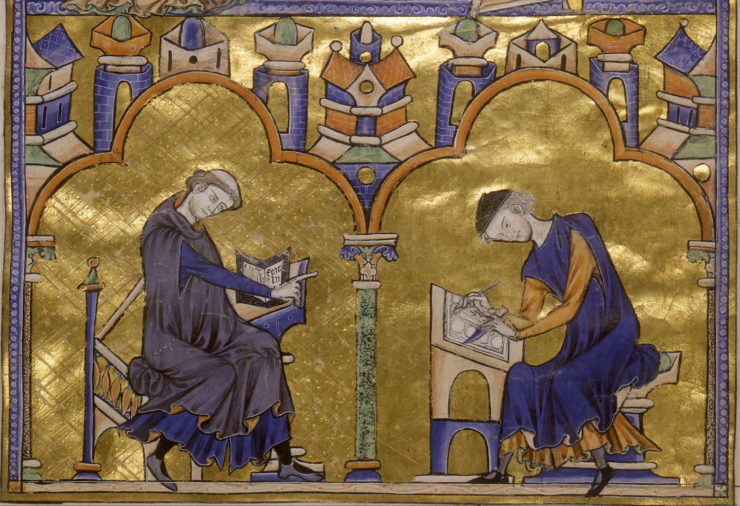We’ve all been there: when out hiking or slogging through fresh snow, it’s much easier to be the person following the trailblazer than it is to be the trailblazer. This is true in writing as well. Writing in established genres is a lot easier once all the conventions have been established. Consequently, for every bold, innovative work there are dozens—hundreds, perhaps thousands—of works that are perfectly content to draw within lines laid down by an earlier author. Often well within the lines.
I fear that naming specific derivative titles here would be a great way to attract angry letters from living authors, provided that they can find an earlier angry letter to emulate. It’s safest to discuss pioneering works, but avoid naming those authors they inspired. Let’s keep the focus on the positive, then…
To inspire imitation, works should be popular and the most popular elements should easily copied. Ease of copying is vital. Consider that Dhalgren was hugely popular, but did not lend itself to emulation. This is why we do not see dozens of Dhalgren knock-offs on bookstore shelves.
But as to popular works that can be copied (in many but not all aspects)…the first that comes to mind is (of course) The Lord of the Rings. I ran a hobby store for seventeen years and sold many a LotR knockoff. True, there are many aspects of Lord of the Rings that do not lend themselves to being copied. It’s safe to say that most authors are not up to the task of creating entire languages from scratch. Many others are not interested in depicting fantasy characters with PTSD like Frodo. But the core of the series—a diverse set of characters setting out to save the world from a big bad—is something other authors can easily copy. And they have.
You may think I have in mind a certain popular series first published in the late 1970s, and I do, but I am also thinking here of a tidal wave of derivative secondary-world quest fantasies, what we called in the old days of USENET “extruded fantasy product,” churned out by a well-known midwestern company that is no longer with us.
Ignore the slight sneer I may or may not be displaying as I type this. I recognize that creating derivative works can be much more challenging than it might seem. It’s not enough to boil a novel work down to the genre-essentials. One has to boil them down to the correct essentials. The most evocative essentials. That may not be straightforward.
Laser Books serves as a cautionary tale: editor Roger Elwood, having transformed the world of SF anthologies beyond recognition, turned his skills to producing a line of short, slickly packaged, unchallenging science fiction for Harlequin, at a pace of three books per month. Offering readers what they want in great quantity seems as sure a recipe for riches as cryptocurrencies or NFTs. In the case of Laser, Elwood buffed off a few too many rough edges. Laser Books quickly languished and died after two years.
Sometimes, making a derivative work requires tweaking the original elements. For example, Lord of the Rings is about (among other things) trying to get rid of an item of immense power. A considerable fraction of the works inspired by Tolkien focus instead on acquiring objects of plot-resolving power. Similarly, military science fiction’s conventions didn’t fully crystalize until the 1980s; the older works that inspired MilSF (Starship Troopers, Tactics of Mistake, or Hammer’s Slammers, for example), works that have been retroactively classified as MilSF, may seem odd to modern readers because they deviate from genre conventions that didn’t exist when they were written.
At their worst, derivative works can be incredibly depressing. If there is anything more soul-crushing than seeing ambitious SF boiled down to pleather-clad razorgirls described in male-gaze-o-vision, cookie-cutter dystopias, and endless action scenes, it’s watching the knock-offs outsell the originals (at least until the inferior copies overfill demand and the entire genre collapses).
At their best, though, core elements provide a foundation to build on, rather than constraining borders beyond which one can never venture. The resulting works aren’t just blurred copies of an original, but bring something new. Works that, in other words, make reading worthwhile. And isn’t that what we want, books that are more than simple time-killers?
In the words of fanfiction author Musty181, four-time Hugo finalist, prolific book reviewer, and perennial Darwin Award nominee James Davis Nicoll “looks like a default mii with glasses.” His work has appeared in Interzone, Publishers Weekly and Romantic Times as well as on his own websites, James Nicoll Reviews (where he is assisted by editor Karen Lofstrom and web person Adrienne L. Travis) and the 2021 and 2022 Aurora Award finalist Young People Read Old SFF (where he is assisted by web person Adrienne L. Travis). His Patreon can be found here.










